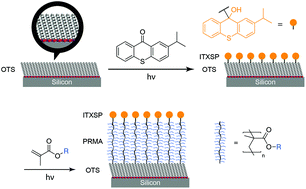Visible light-induced controlled surface grafting polymerization of hydroxyethyl methacrylate from isopropylthioxanthone semipinacol-terminated organic monolayers†
Abstract
A visible light-induced living polymerization of a hydrophilic model monomer was initiated on organic silane monolayers using isopropylthioxanthone (ITX). The type II photoinitiator ITX was covalently introduced to the octadecyltrichlorosilane monolayers by UV-induced (254 nm) hydrogen abstraction and a subsequent coupling step through recombination. The resulting dormant isopropylthioxanthone semi-pinacol (ITXSP) groups can be reactivated by irradiation with visible light to initiate a controlled surface grafting polymerization. Using this surface-initiated polymerization approach, hydroxyethyl methacrylate (HEMA) was polymerized under visible light irradiation (385 nm) at room temperature. The polymer layer thickness depends linearly on the irradiation time, which is in good agreement with previous reports on the living characteristics of the polymerization reactions. It is possible to accurately control the thickness of the grafted layer by simply altering the irradiation time.



 Please wait while we load your content...
Please wait while we load your content...
